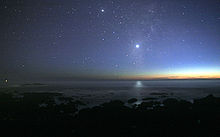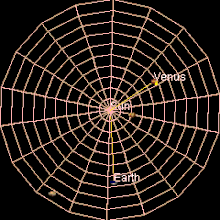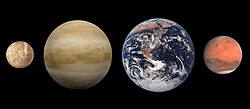Venus is the second planet from the sun in our solar system. Here are some important, scientific and interesting facts about this planet.
1.) The planet was named for Venus, the Roman goddess of beauty – the equivalent of the Greek’s Aphrodite.
2.) Although Venus is second only in distance from the Sun, it is the hottest planet in the solar system
3.) Venus is the brightest object in the sky except for the Sun and the Moon.
4.) Venus is unique because it also lacks a magnetic field and a moon.
5.) The hellish surface of Venus has broiling temperatures that make rocks glow red.
6.) Venus is the nearest planet to Earth in distance at about 41 million km away at its closest approach.
7.) Venus is nearly the same size as Earth hence; they are sometimes called twin or sister planets.
8.) Venus takes 243 days to rotate on its axis in the opposite direction.
9.) Venus circles the Sun once every 224.7 days or a little over seven months in a counterclockwise direction, the same direction as the other planets in the solar system at a distance of 108 million km.
10.) Venus is often called the “morning star” when it appears in the east at sunrise and the “evening star” when it is in the west at sunset.
11.) In ancient times the morning star is called Phosphorus, Eosphoros, or Lucifer and the evening star was called Hesperus.
12.) Venus’ axis is nearly vertical and its orbit is nearly circular so it does not experience seasons the way Earth and Mars do.
13.) Venus rotates very slowly, once every 243 Earth days. Venus’s rotation is retrograde, which means that the planet turns clockwise (from east to west) as seen looking down on its north pole.
14.) Earth and most other planets turn counterclockwise (from west to east).
15.) A full solar day on Venus—the time when the Sun next passes the noon point in the sky—is 116.8 days long.
16.) Viewed from a spot on the equator of Venus, the Sun rises in the west and takes 58.4 days to cross the sky until it sets in the east. Night also lasts 58.4 days.
17.) The atmosphere of planet Venus consists of 97 percent carbon dioxide (CO2) and is so thick that the surface pressure is 96 bars. The earth is 1 bar only.
18.) Venus’ surface temperature is extremely hot which is about 462°C or hot enough to melt lead.
19.) Venus is only slightly smaller and less dense than Earth. Its radius is 6,052 km and its average density is 5.2 g/cm³.
20.) The surface of Venus is primarily a rolling plain interrupted by two continent-sized highland areas named Ishtar Terra and Aphrodite Terra.
21.) The Magellan spacecraft has revealed huge volcanoes, large solidified lava flows, and a large array of meteorite craters.
22.) The largest impact crater in Venus is almost 300 km across—the smallest about 5 km.
23.) There is also evidence that a great deal of tectonic activity has taken place on Venus, at least in the past.
24.) Evidence of tectonic activity includes ridges, canyons, a trough-like depression that extends across 1,400 km of the surface, and a gigantic volcanic cone whose base is more than 700 km wide.
25.) Because the size and density of Venus and Earth are so similar, scientists think the two planets originated in the same way.
26.) Venus, Earth and other planets on the Solar System were formed about 4.6 billion years ago out of the spinning disk of dust and debris that surrounded the newborn Sun.
27.) The first flyby sent to Venus was that of Mariner 2 of the US
28.) The former Union of Soviet Socialist Republics
29.) In 2005, the European Space Agency (ESA) launched the Venus Express spacecraft on a mission to Venus and started orbiting Venus in 2006.
30.) The Venus Express also carried the first infrared instrument designed to study the planet’s surface at infrared wavelengths, making it possible to detect active volcanoes if they exist.
31.) The stifling atmosphere in Venus is so dense that even a slow breeze would feel like a tremendous gust.
32.) If humans can be in Venus, the Sun would be only faintly visible through the dense clouds and the entire surface would appear yellow-orange during day time.
33.) During nighttime in Venus, it would not be dark – the entire rocky landscape would glow a dull red like the burner on an electric stove.
34.) If the concept of hell is true, Venus may be the closest thing in the solar system comparable to hell.
35.) A human in Venus would weigh about the same as on Earth.
36.) The size comparison of terrestrial planets from left to right: Mercury, Venus, Earth and Mars.
37.) The planet’s surface gravity is nine-tenths as strong as surface gravity on Earth; an object that weighs 10 kg on Earth would weigh 9 kg on Venus.
See also




No comments:
Post a Comment